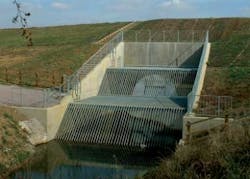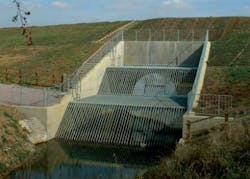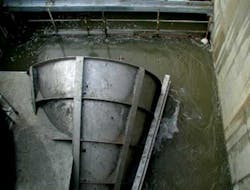Harnessing the Vortex for Large-Scale Flood Control
By Robert Y.G. Andoh
There are nearly 100,000 dams operating throughout the United States. These dams serve a variety of purposes, including water supply regulation, agriculture water supply, hydroelectric energy generation and fire protection. Although it’s not generally known, the third most common use is for flood control.
Figure 1: An exterior view of a vortex valve in Weedon Bec, UK. The unit installed at Weedon Dam has the facility to adjust the controlled outflow between just over 2,000 to 3,000 gallons per second via the use of removable stop logs on its intake.
Flooding caused by heavy rain events can overwhelm stormwater sewers and local watercourse capacity, causing extensive damage downstream. To alleviate downstream flooding during heavy rain events, there are two principal strategies that engineers can employ: building up the community’s flood defences, or holding back and storing flood waters upstream of the community.
Building up a community’s defences is an expensive and disruptive proposition. Municipalities would need to enlarge their existing conveyance channels or create higher embankments or shored-up levees to ensure that heavy flows don’t flood local streets. This can be a challenge in many existing urban areas where residential and commercial buildings have been built close to the channels. To ensure adequate protection, local leaders often have to resort to land takings.
Holding back flows with a dam before they reach downstream communities is usually the more efficient, cost-effective strategy. An orifice control is used to ensure that flows passing through the dam are limited to a rate that is safe for the downstream conveyance channels, thus preventing flooding. During heavy rain events, excess flow is held back and allowed to build up in a temporary flood plain behind the dam. After the heavy rain event, the stored water is released back into the conveyance channels.
Flood prevention dam structures are usually sited amid farmland — allowing a temporary floodplain that recedes once the heavy rainfall ends. Where land purchase costs or compensation costs are required, they are substantially less than in urban situations.
Because the dam strategy requires land take upstream, it makes sense that this land take is kept to an absolute minimum while still preventing damaging floods downstream. Harnessing an engineered vortex flow control greatly reduces the amount of land take required compared to a standard orifice type flow control.
Vortex valves act like natural hydraulic brakes. High flows initiate a vortex within the valve, which in turn restricts the flow of water through the device. A vortex valve has a unique performance element: it allows more flows through at lower heads than an equivalent orifice plate. This means that flows will be at the maximum safe rate much earlier in a heavy rain event, resulting in a significant reduction in storage/land requirement. These valves are currently used in the U.S. for flow control purposes in urban drains and ponds, but they haven’t yet been applied to dam projects.
In the United Kingdom, however, three such flood prevention schemes are already in use, with more planned or under construction. One example can be found in the village of Weedon Bec, situated west of Northampton. In 1998 the village suffered severe flooding from the River Nene due to the limited capacity of culverts under a railway embankment downstream of the village and at a road bridge within the village.
To protect against the flooding, engineers considered a wide range of options. Increasing the capacity of the channel required the existing river channel to be doubled in size. This would have resulted in loss of land and fundamentally would only have transferred the problem further downstream. Containment of floodwater within the river channel would have also required construction of floodwalls through 30 private gardens, the costs of which were very high and the resulting disruption to residents unacceptable. It soon became evident that the most viable solution was the provision of upstream flood storage.
A site was identified less than a mile upstream of the village where the river flows through a well-defined valley with little habitation, forming a suitable location for a flood storage scheme. The project team decided the best solution was to install vortex flow control to attenuate the peak flow. A conical (C-type) vortex valve from Hydro International was chosen on the basis of its simplicity, low maintenance requirements and relatively lower cost for this site. Other options for controlling flows through the culvert such as a fixed orifice, an actuated penstock or a float-operated radial gate were considered but discounted due to lack of power supply, the unrealistic expectations of maintenance and the risk of operational failure of equipment with moving parts.
Figure 2: Vortex valves act like natural hydraulic brakes. Designed with a snail or conical shape, high flows initiate a vortex within the valve which in turn restricts the flow of water out of the device. When head pressure builds, water circulates in a vortex pattern, allowing an air core to form within the device limiting discharge from the dam.
Instead, vortex valves offered flexibility and ultimately attenuated the peak flow through Weedon Bec from 7,000 gallons per second to the in-bank capacity of the river channel through the village of 2,600 gallons per second during a 50-year event. Additionally, rather than send flows downstream to be dealt with later, vortex valves were able to regulate flows and allow drainage systems to distribute them in a more natural manner. Today, the unit installed at Weedon Dam has the ability to adjust the controlled outflow between just over 2,000 to 3,000 gallons per second via the use of removable stop logs on its intake.
To solve future water issues in the most economical, efficient manner possible, it will be necessary to adopt integrated water management plans that prevent problems before they occur. The use of vortex valves is one method of ensuring those plans can work.
About the Author
Professor Robert Y.G. Andoh is Chief Technical Officer and Executive Director at Hydro International Inc.


